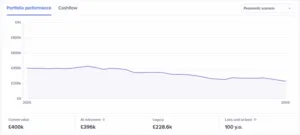30 Sep 2025
Who we can help: When might an annuity help your retirement?
In 2024 sales of annuities in the UK reached a ten-year high, with a 24% increase from 2023, to a total of 89,600 contracts sold, according to the Association of British Insurers (1). This is a far cry however, from earlier generations, where annuities were almost a default choice on retirement. According to The Guardian (2), in 1990 a typical 65-year old male could convert his retirement savings into an annuity at a rate of 15.5% per year – meaning that for every £100,000 of investments he would receive £15,500 per year of income.
What do annuity rates look like now? A healthy man reaching age 65 today, will typically only be offered somewhere between £7,400 and £7,600 per £100,000* invested to purchase a retirement annuity (*no survivor benefits, guarantee periods, or other add-ons included in this rate).
Why have annuity rates fallen so far? The short answer is longevity. In 1990 the average life-expectancy of a male 65-year old was 15 years, typically surviving to age 80. Today the same male 65-year old is expected to live for 20 years (a 33% increase), and according to ONS statistics, there’s a 25% chance they’ll live to age 92 (27 years from age 65). The insurers selling an annuity have had to factor in a far greater life-expectancy so the amount they offer to pay each year has decreased. The other critical factor is prevailing interest rates at the time of the annuity purchase. Annuities were even less effective (or attractive) when interest rates were below 2% for much of the 2010’s, and the recent resurgence in appetite for them has come with the return of higher, more ‘normal’ interest rates.
Although they are less fashionable now, there are still some circumstances in which an annuity may be a useful option for those embarking on, or in retirement.
First, if you have a pension with safeguarded benefits, this can sometimes include what is known as a Guaranteed Annuity Rate (GAR). These are often older pensions, where the rate of annuity offered was set many years ago – and sometimes this rate is significantly better than anything available on the open market for annuities today. Any time you have a pension of this type, you should obtain professional advice before deciding what to do with the pension.
Second, although we’re all conditioned to tell insurers that our health is good and that we behave ourselves completely and do all the healthy things and none of the unhealthy ones, ironically, when it comes to annuities, being a smoker or having serious ill-health, can increase the annuity available. That is of course because ill-health will tend in actuarial models to predict a shorter life-span. These things are usually exhaustively covered by medical underwriting, so it’s unlikely to be useful to take up smoking right before you retire! Moreover, dying before the age of 75 with a drawdown pension pot can actually work out quite favourably for the recipients from an income-tax perspective, much better than dying in the early years of an annuity. However, no-one wants to aim to die early in retirement, so this is not a promising avenue for planning.
Third, an annuity can become much more attractive at a later stage in retirement. Today, a 75-year old male in good health, will be offered a range of £8,880 to £9,160 of income per £100,000 invested to purchase the annuity. By age 75, most people have at least some health ailments, which means that it may well be possible for them to obtain even better annuity offers.
The once traditional approach of taking an annuity with almost the entirety of one’s retirement funds is no longer very common. Not least because a typical annuity does not offer increased payments over time (this costs more – see below). Which means that as the years pass, the value of the payment received from the annuity decreases because purchasing power is eroded by price-inflation. If we return to our example of a healthy male who has just turned 65 today, an annuity with 3% annual escalation is offered at a range from £5,180 to £5,680 – more than £2,000 less of income per year for each £100,000 spent to purchase the annuity. However, the value each year of the annuity continues to grow in purchasing power as long as inflation is less than 3%.
Despite these challenges, using a portion of your pension to purchase an annuity can provide a great stabiliser to overall retirement planning. This is because an annuity may be used to take the place of some of the lower-risk assets of your overall portfolio for retirement. The resultant shift of your remaining retirement portfolio to a slightly higher risk strategy, can do much to shore up your overall retirement income sustainability.
Below we see an example cashflow forecast for a person just starting their retirement, who has £500k in a personal pension, invested in a ‘Moderate’ portfolio (60/40 equities/bonds) which needs to cover £25k per year of expenses escalating by inflation each year (we assume tax-free cash has already been taken so all remaining funds are for drawdown). In a pessimistic scenario, by age 100 the portfolio has nearly completely run out, meaning that this retirement may not be sustainable if there are exceptionally adverse market conditions, particularly if these occur early in retirement.

An alternative is that the same person uses £100k of their pension pot to purchase an annuity. This grants them £7.5k per year of annuity income, leaving £400k invested. Because they have the security of the annuity income contributing toward their overall income requirement of £25k per year, the remaining pension is adjusted to a Moderately Adventurous portfolio. The revised cashflow forecast is predicted to be a substantial legacy still available at 100 years old, and a plan that is much more likely to be sustainable throughout retirement.

In the latter example, the stability of an annuity income allows for other investment choices to be made which may add to overall retirement sustainability. Careful planning and consideration of your options is not just something to do before you retire. It continues to be relevant well into retirement, as we can see from the above choices around annuities and their uses.
What are your retirement plans? Do you have clarity about how an annuity could be relevant or useful to your overall retirement strategy?
If you’d like to discuss achieving peace of mind around your retirement, please book a free initial chat here:
https://calendly.com/duncan-bw-hoebridgewealth/30min
Download our free guide to retirement planning
NOTE: None of the above is financial or investment advice and you should speak to me or someone else professionally qualified to give you advice specifically tailored to your circumstances. A pension is a long-term investment not normally accessible until 55 (57 from April 2028). The fund value may fluctuate and can go down, which would have an impact on the level of pension benefits available. The tax implications of pension withdrawals will be based on your individual circumstances. Thresholds, percentage rates and tax legislation may change in subsequent Finance Acts.
Links:
1 – ABI data
2 – The Guardian


 Production
Production